Last Updated on May 30, 2022
As in many of the dusty, provincial cities just off the trail in South East Asia, Battambang has several tourist activities, which can be covered on a one-day tuk-tuk tour and we already had certain images conjured up about this bamboo experience from other travelers we had met on the road, guidebooks and other travel blogs. We first heard about it over on Alex in Wanderland’s post: A Weekend in Battambang.
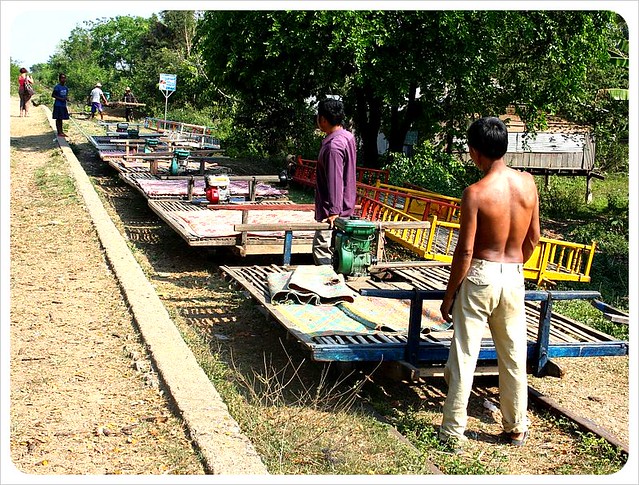 We knew there would be a single track used to transport goods years ago and I pictured an old-fashioned train made out of bamboo, or maybe the tracks would be bamboo, too. Maybe out in the Cambodian countryside we would find another piece of evidence in favor of the world’s most eco-friendly and sustainable building material. Either way, other travelers we had met made it seem like a really fun, possibly ‘awesome’, rustic experience not to be missed. (Check out the video at the end and let us know if you would take part.)
We knew there would be a single track used to transport goods years ago and I pictured an old-fashioned train made out of bamboo, or maybe the tracks would be bamboo, too. Maybe out in the Cambodian countryside we would find another piece of evidence in favor of the world’s most eco-friendly and sustainable building material. Either way, other travelers we had met made it seem like a really fun, possibly ‘awesome’, rustic experience not to be missed. (Check out the video at the end and let us know if you would take part.)
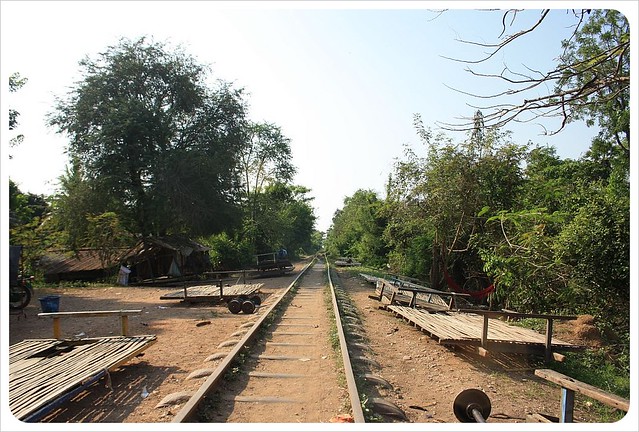 The next day, our guide drove us in a motorized tuk-tuk on a main road out of town, then onto a smaller road which eroded into a bumpy dirt road and eventually pulled up next a couple of falling down tourist stands.
The next day, our guide drove us in a motorized tuk-tuk on a main road out of town, then onto a smaller road which eroded into a bumpy dirt road and eventually pulled up next a couple of falling down tourist stands.
We were hastily herded to the track. In the distance, the sun bounced off the steel in a way that revealed weathered metal forming a warped line of track. Looking down, a flat contraption made of simple wood planks was the ‘train’ and the only bamboo was a woven netting we would sit on to keep us from falling through to the track below. The mechanism was just set down on two steel pulleys. It was not bolted down or even tied together with a piece of string. This is because it would be taken apart and put held together several times throughout the next hour.
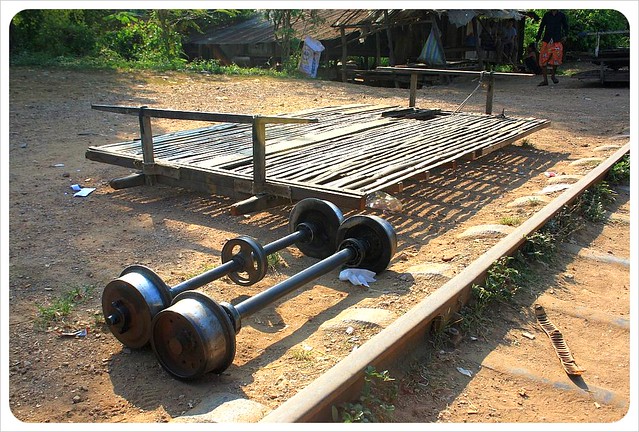 This wasn’t the first time we found ourselves confronted with a strange and definitely unsafe oddity but thought we would be enjoying the sprawling Cambodian countryside slowly as if on a flying carpet on wheels, past vast forests of palm trees and open spaces of farm land, watching families of white cows grazing and endlessly swatting flies with their wiry bald tails.
This wasn’t the first time we found ourselves confronted with a strange and definitely unsafe oddity but thought we would be enjoying the sprawling Cambodian countryside slowly as if on a flying carpet on wheels, past vast forests of palm trees and open spaces of farm land, watching families of white cows grazing and endlessly swatting flies with their wiry bald tails.
 Instead, we were nudged by the police officer for our $5 each, told to sit down and face forward and before we even glimpsed our ‘conductor’, the ‘train’ was speeding down the track faster than we could have imagined possible. We whipped our heads round to see a young guy in a straw hat, a red T-shirt and stylish skinny jeans with a cigarette hanging out of a disinterested smirk.
Instead, we were nudged by the police officer for our $5 each, told to sit down and face forward and before we even glimpsed our ‘conductor’, the ‘train’ was speeding down the track faster than we could have imagined possible. We whipped our heads round to see a young guy in a straw hat, a red T-shirt and stylish skinny jeans with a cigarette hanging out of a disinterested smirk.
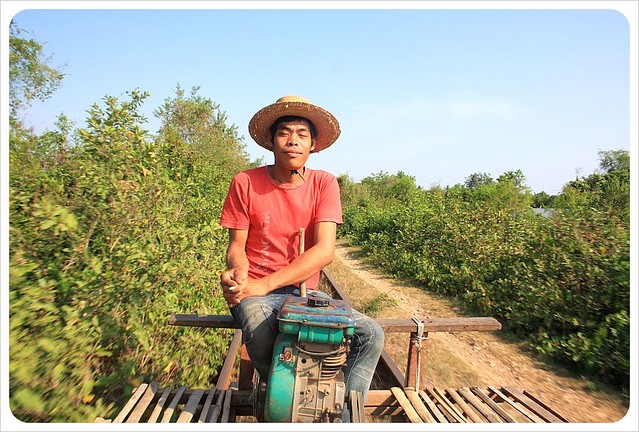 Forget the countryside! Our knuckles had now turned white gripping the only piece of second-rate timber in front of us and I began calculating… If bamboo train A is traveling at 100mph in one direction and train B is traveling at the same speed in the other direction, how many bones would be broken if we all crashed?
Forget the countryside! Our knuckles had now turned white gripping the only piece of second-rate timber in front of us and I began calculating… If bamboo train A is traveling at 100mph in one direction and train B is traveling at the same speed in the other direction, how many bones would be broken if we all crashed?
 Luckily we had arrived early and not one train passed us coming the other direction all the way to the end. Unluckily, this meant miraculously flying over gaps in the tracks and thundering over broken bridges for fifteen minutes and reached the end of the track wind-whipped and relieved, only to find more rickety stalls selling typical Cambodian handicrafts and fruit and beer.
Luckily we had arrived early and not one train passed us coming the other direction all the way to the end. Unluckily, this meant miraculously flying over gaps in the tracks and thundering over broken bridges for fifteen minutes and reached the end of the track wind-whipped and relieved, only to find more rickety stalls selling typical Cambodian handicrafts and fruit and beer.
 Yes, we were thirsty. Yes we can buy something for $1.
Yes, we were thirsty. Yes we can buy something for $1.
But everything about this felt so wrong.
These people live deep in the countryside in shacks surrounding a track used only for tourists, their entire income dependent on selling useless goods to foreigners.
Instead we accepted a ten-minute tour of the nearby rice factory from a nine year old girl with perfect English and honest eyes. She explained how the rice is milled and showed how the sacks were separated into the stocks that feed the people and those for the livestock. At school they don’t learn English, she told us, and she learned just from talking to foreigners here at the end of the Bamboo train track. She left a big impression on us and we gave her a tip instead of buying beer (at 9am!).
 There were now half a dozen bamboo trains lined up and tall, white people mulling around the shacks and two sat drinking Angkor beers. Our cart was now at the back of the line (there is no order to this) and as we waited for everyone to finish I decided I would film the trip back.
There were now half a dozen bamboo trains lined up and tall, white people mulling around the shacks and two sat drinking Angkor beers. Our cart was now at the back of the line (there is no order to this) and as we waited for everyone to finish I decided I would film the trip back.
The way back was much more bizarre.
This time several trains came toward us and we rarely reached full speed. Instead, we all took turns dismounting and taking apart our ‘train’ off the track for the others to pass. First conductors lifted the top part off and then each of the pulleys was lifted off the track while all the tourists, Europeans, Americans and a few Asians waited amused on the side of the tracks. We passed a mix of well-dressed, older tourists and young backpackers.
No matter the age, we all shared one thing in common.
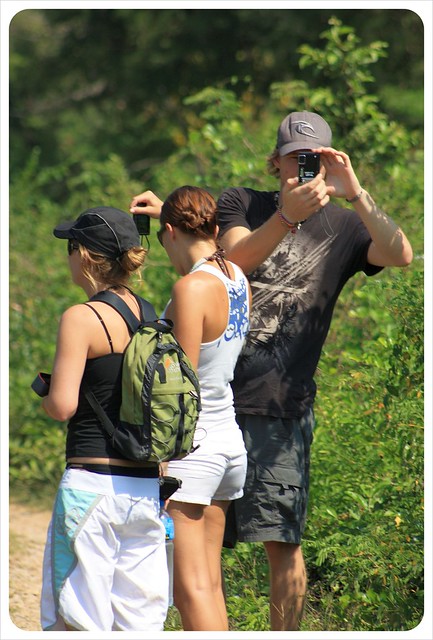 It wasn’t just us with cameras out. All the tourists were documenting the bamboo train experience with their video cameras, iPhones, iPads, iPods and DSLR cameras, some with lenses as big as paparazzi lenses. Dani and I were no longer documenting the bizarre train experience.
It wasn’t just us with cameras out. All the tourists were documenting the bamboo train experience with their video cameras, iPhones, iPads, iPods and DSLR cameras, some with lenses as big as paparazzi lenses. Dani and I were no longer documenting the bizarre train experience.
Instead, we could not get over the tens of thousands of dollars’ worth of technology that filled this stretch of track.
This gap-filled warped track.
The $5 ride.
The $1 beers at the end of it.
 What about the $15 price of hiring a guide for the entire day, or the ‘For Rent’ sign on a newly built apartment building in the center of Battambang. Written in English and aimed at foreigners, monthly rent was set at $70 per month.
What about the $15 price of hiring a guide for the entire day, or the ‘For Rent’ sign on a newly built apartment building in the center of Battambang. Written in English and aimed at foreigners, monthly rent was set at $70 per month.
And here we all were, collectively totting around gear that can film, photograph, even edit and upload to the internet like some sort of technology trade show and not one of us is a filmmaker.
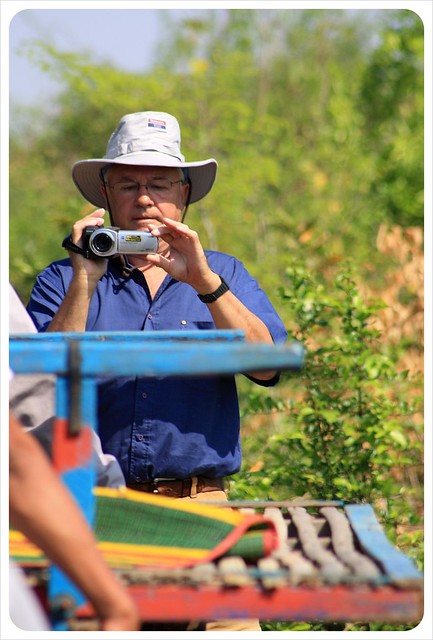 What I could stop thinking about was how this scene, a once-in-a-lifetime experience for us, is a seven-day-a-week operation. Every day those involved see well-dressed foreigners with enough technology to build an entire village even at cut-rate resale price, some of whom don’t even buy that $1 scarf or bottle of water.
What I could stop thinking about was how this scene, a once-in-a-lifetime experience for us, is a seven-day-a-week operation. Every day those involved see well-dressed foreigners with enough technology to build an entire village even at cut-rate resale price, some of whom don’t even buy that $1 scarf or bottle of water.
 We bought nothing, our lack of purchase based on general principle.
We bought nothing, our lack of purchase based on general principle.
But what is the principle again?
In Cambodia, no matter where we went, locals smiled at us, ran out of their houses just to wave as we passed by. How do they not hate us? The bigger question, though, is why everyone else seemed so okay with this bamboo train experience.
Why did no one mention this awful irony of a railroad system no longer used for shipping commerce now charging $5 to send rich foreigners with enough money to rebuild the city down a track on a rickety bamboo train to make $1 purchases at the end of it?
Would we have gone anyway? What good is withholding the $10 they made from us that day on the bamboo train?

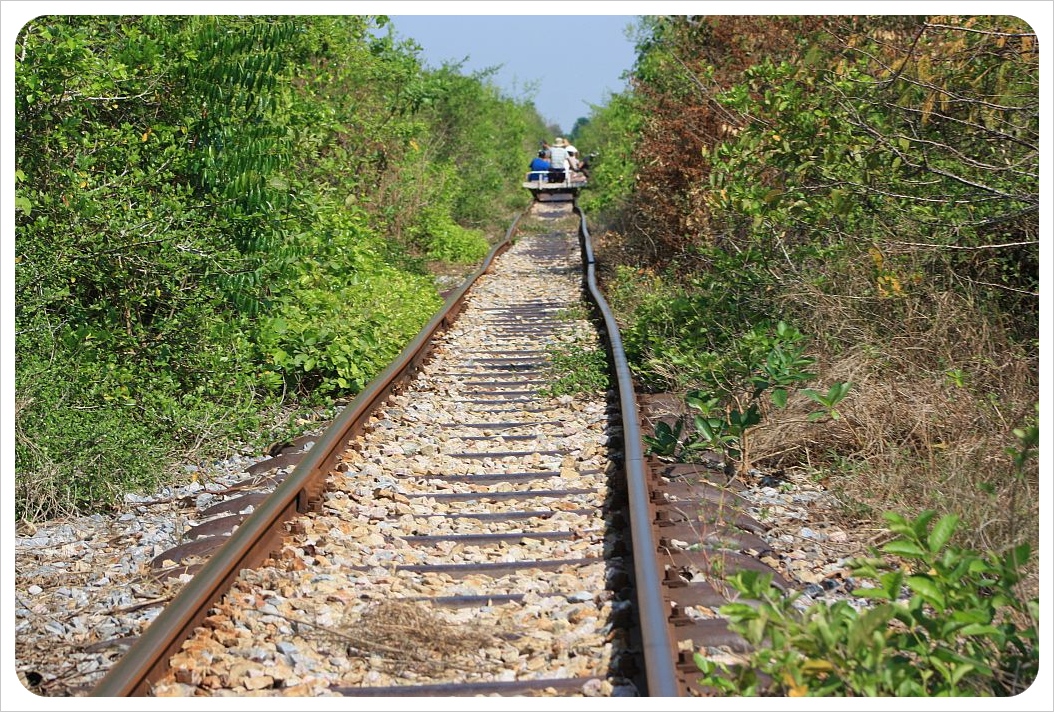
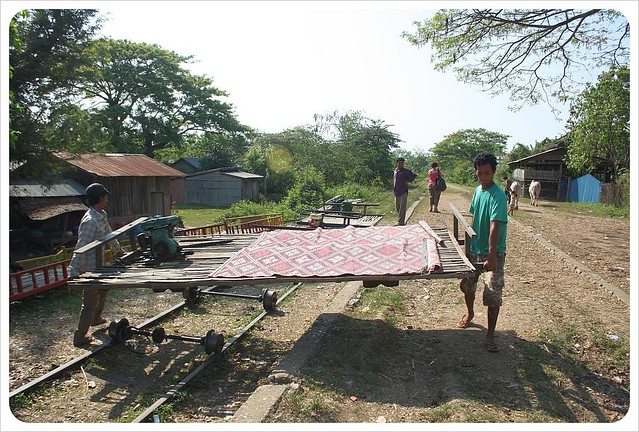



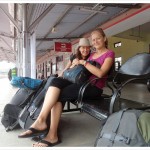
Will
Tuesday 15th of October 2013
I too notice the large amount of money spent on gear that we use to photograph the poor villagers in cambodia. However, I just took the bamboo train and there were more locals using the trains than tourists. 4 times we had to get off and dismantle our train because trains with 20 locals on them were headed the other way. we also saw a few trains being loaded with huge blocks of ice and sent down the tracks. I commented on how bad must the roads be for these villagers to use the train line to go between villages. we stopped at the turn around for a while and had a coffee and saw sever trains with locals coming and going. so its not just for tourists.
steve
Sunday 13th of January 2013
We were riding motorbikes around Kampot when we came upon a few shops and a railroad crossing ,with somm guys on a small bamboo type train they were using for work.[they were working on the tracks about 3-4 k away. They were super friendly and next thing we knew,bikes were parked and off we went ,with the wind blowing through our hair,sitting on bags of cement,heading out into the wilderness. When we arrived we were introduced to the other workers [quite shy] and we got out and spent some time out on the railroad bridge a short distance away. after an hour or so we said our ''byes'',hopped back on and back we went. It was an awesome ''no strings attached'' experience that highlighted the wonderful ''Cambodian nature'' i guess we traded our somewhat ''foreign novelty'' for a cool little adventure for us. we were very fortunate to have been in a situation a bit different to some of the previous posts--a tiny bit like the little girl experience. I know there's an element of danger with motorbikes but the freedom they allow to get out in the middle of nowhere with the people is worth the risk IMO We later found an Outfit that used donations to build water tanks for villages in need ,so hopefully we have done our small part.
Alex
Monday 5th of November 2012
I'm commenting on this like a million years late, but I got so overwhelmed with reading blogs at one point that I started a "to comment' folder... just getting to it now! First of all, thanks for the shout out!
Second, I'm sorry you didn't have as great of a time as I did. I have to say, we had a completely different experience. We passed one group each way, there and back, and I was by far the one with the fanciest recording equipment. The others were also off-the-track looking backpackers. So maybe it seemed more authentic to me. I'm pretty sure I would have asked similar questions if a guy was there taking photos with an iPad... ha.
Dani
Thursday 8th of November 2012
Alex- I wish it had just felt a little bit less like a tourist circus... Reading about it on your blog I loved the idea of taking this old, rickety train through the Cambodian countryside, it just sounded so dreamy and unique. It was still an interesting experience and I don't regret that we did it :)
northierthanthou
Sunday 23rd of September 2012
Ha! ...wild way to get around. the bridge would sure give me pause.
Steve C
Monday 3rd of September 2012
I backpacked around the world for two years about 25 years ago and this conundrum was debated at length by all us travelers where ever we went.
I chose to be the fly on the wall, the bird soaring above, an observer only. It's a huge world, and I'm occupying it for the blink of an eye with respect to the vastness of the universe and infinity of time. I choose my battles and know the war will go on, but also that nothing gets done unless I do it and promote change.
I'm planning on voting this fall. Have you ordered your absentee ballots yet, to be sent to a pick-up location, if you still plan to be out of the country?
Keep questioning and Happy Trails!
Steve C
Monday 3rd of September 2012
Oops, as I'm a newcomer to your blog, and I've just read several of your posts, you are Germans! As I'm an American, I'll be voting this fall. However, I'm sure Germans vote too (ha, ha).
So, the voting thing still goes. It's the least thing we can all do, no matter where we call "home".
BTW; all my ancestors are Germans.